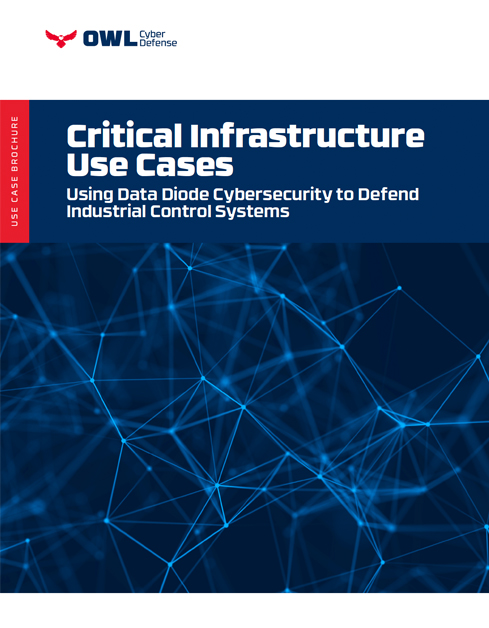DOWNLOAD USE CASE BOOKLET
The Next Generation of Cybersecurity Solutions
The United States Department of Homeland Security (DHS) defines 16 sectors of critical infrastructure, whose assets, systems, and networks are considered to be vital to the United States such that their debilitation or destruction would have a significant effect on the nation’s security, economy, and/or public health and safety.
The 16 Sectors of Critical Infrastructure
- Chemical
- Commercial Facilities
- Communications
- Critical Manufacturing
- Dams
- Defense Industrial Base
- Emergency Services
- Energy
- Financial Services
- Food & Agriculture
- Government Facilities
- Healthcare & Public Health
- Information Technology
- Nuclear Reactors, Materials, & Waste
- Transportation Systems
- Water & Wastewater Systems
This paper outlines 19 use cases for the implementation of Owl data diode cybersecurity to defend a variety of these critical infrastructure sectors. The use cases feature industry leaders and demonstrate how Owl helped them meet a number of security and operational requirements through a one-way, deterministic data flow.
In each of these cases, Owl data diodes are interoperating with a wide array of leading operational technologies, including, but not limited to: OSIsoft® PI System, Schneider Electric Wonderware, GE Historian, Rockwell Automation FactoryTalk®, Modbus, OPC, mobile networks, and software firewalls. Please see the Index at the end of this document for a full list and references for all sectors and technologies included.
![]()

We hope these use cases provide a good introduction into the capabilities of Owl and some of the ways data diodes can be used to solve today’s cybersecurity issues.
Use Cases:
- Global Oil & Gas Company Enables Secure, One-Way Production Data Transfer to HQ
- Natural Gas Company Enables Secure Transfer of Production Data to HQ for Remote Monitoring
- Gas Turbine Support Vendor Enables Centralized Remote Operation & Maintenance Monitoring
- Petrochemical Company Enables Secure, One-Way Production Data Flow to Business IT
- Rare Earth Mining Company Secures Operational Network from Advanced Persistent Threats
- Water/Waste Water Company Implements DHS Defense-In-Depth Cybersecurity Strategies
- Nuclear Power Facility Meets US Nuclear Regulatory Commission Cybersecurity Regulations
- Coal Power Facility Meets NERC CIP Version 5 Cybersecurity Regulations
- Natural Gas Power Facility Meets NERC CIP Cybersecurity Regulations, Enables Vendor Remote Monitoring
- Public Power Authority Meets NRC, NERC CIP Cybersecurity Regulations Across 10 Plants
- Power Transmission and Distribution Substations Meet NERC CIP Version 5 Cybersecurity Regulations
- National Bank Secures ATM Data Collection via Email at Central Repository Database
- Regional US Bank Enables Remote Network Monitoring
- Mid-Market National Bank Captures and Collects Forensic Data Files
- Regional US Bank Secures Offsite Backup of Transactions and Customer Records
- National Commuter Rail Transportation Company Secures Remote Monitoring of Railcars and Track
- Healthcare System Secures Research Database of Electronic Medical Records
- Secure Remote Monitoring of Video Surveillance and Alarms Enabled at Nuclear Power Facility
- National Grid Operator Protects Plants and Secures Remote Monitoring

